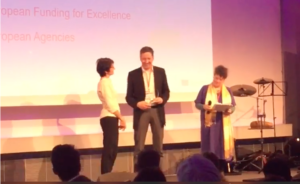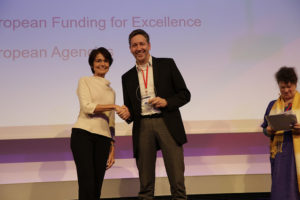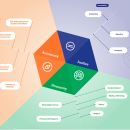The third European Vocational Skills Week (EVSW) took place this week in Vienna (Wien). The event has been launched by the European Commission to draw attention to the importance of vocational education and training (VET) for education, economy and society. Our European VETNET network has also played a role in drawing attention to the contribution of VET research to the development of VET. However, due to several intervening factors I have not been able to attend to these events. Yet, this time I was somewhat more engaged in the preparation and followed more keenly the news from Vienna.
The competition for European VET Excellence Awards 2018
As usual, during the EVSW, there was also this year the competition for European VET Excellence Awards for different kinds of contributions to the development of VET. In the category "European VET Research Excellence" the jury had nominated two European research projects for the final competition:
- The Learning Layers (LL) project that carried out a complex Europe-wide R&D project for studying the use of digital tools, web resources and mobile technologies to support learning in the context of work. The project engaged application partners in healthcare sector (UK) and construction sector (Germany) in co-design, pilot testing and actual use of new tools. In the competition the project was represented by the scientific coordinator Tobias Ley from Tallinn University.
- The Modelling Vocational Excellence (MoVE) project is a transnational project that has studied World Skills competitions at the national, European and wider international contexts. The aim of the project is to draw conclusions from competition processes for the development of everyday life practice in the field of VET. This project was represented by the scientific coordinator Petri Nokelainen from Tampere University.
After the nomination the finalists were presented on a special website for public voting that took place during the last weeks before the event and during the first two days. On the evening before the closing ceremony the finalists in different catergories had the opportunity to give short pitches to make their case. Then, in the closing ceremony the nominees of each category were invited and the winner was declared. Concerning the award for VET Research Excellence I was pleased to see a video recording and to hear the words: "The award goes to ... Learning Layers". As fair competitors Petri and Tobias congratulated each other. And then Commissioner Marianne Thyssen handed the award to Tobias Ley.
Celebrating the award winner Learning Layers
Firstly, let us do justice to both finalists - the two international projects and the teams involved - and for the fair competition. This was a good way to present European and international VET research at such an event.
Then, coming to our Learning Layers project: Why are we so happy that we got the award fror European research in the field of VET (vocational education and training)? Here I am speaking in particular for the partners of the Construction pilot - research partners, technical partners and application partners from the construction sector. I would like to raise the following arguments for us as award winners:
- A substantial part of Learning Layers pilot activities were carried out in the context of apprentice training for construction sector in North Germany. In this context the project was developing a digital toolset “Learning Toolbox” to support work process-oriented learning. Now, in the initial pilot context - the training centre Bau-ABC - the Learning Toolbox will be introduced to the training of all occupations.
- The co-design and tools deployment processes were carried out as participative Research & Development dialogue. In this dialogue practitioners, technical partners were developing tools that promote a culture of self-organised learning in different craft trades.
- The project organised training of trainers in such a way that they could act as promoters of innovation and adjust the use of tools to match their pedagogic priorities (self-organised search of knowledge within a wide set of resources vs. gradual extension of resources that are available for learner). The ‘theme room’ approach is being used in the further promotion of the tools by other trainers.
- After the end of the Learning Layers project there have been several follow-up initiatives to spread the use of Learning Toolbox to support practice-based learning in Vocational and Higher Education (e.g. in Estonia and Spain). These pilots have involved also other sectors (e.g. education/training in healthcare and media occupations).
- A major spin-off arising from the Learning Layers is the use of Learning Toolbox as support for ePosters in conferences. This was started in the conferences for medical and dental education (AMEE, ADEE) and in the conference for technology-enhanced learning (ECTEL). Most recently the ePosters were piloted in the European Conference on Educational Research (ECER) in the network for research in vocational education and training (VETNET).
The points above make it clear that the Learning Layers project was not merely a theory-driven or a tool-driven project. Instead, the project took a high risk in launching open-ended co-design processes and was very much dependent on the cooperation with practitioners in the pilot sectors. Moreover, the tools that were developed in the project - notably the Learning Toolbox - reached the stage of viable products. But in order to bring them further as tools for regular use, additional efforts were needed by the tool developers, practitioners and supporting researchers. These efforts have pointed out to be successful and it was fortunate that reports on recent success were communicated in the event. Thus, the award was a recognition of all the work that contributed to our success. Now we can celebrate, next week we have to take further steps in our work.
More blogs to come ...











